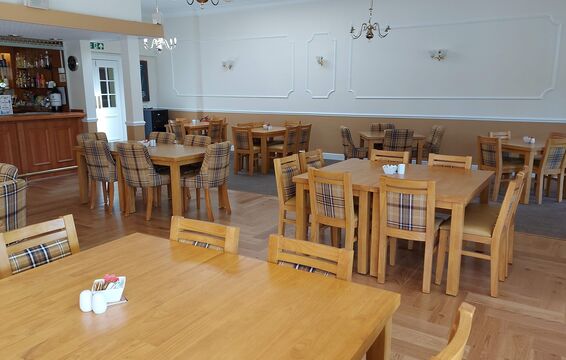
Golf Etiquette
I invite everyone to read these guidelines in the spirit in which they are intended and for the improvement of golf at Drayton Park Golf Club
Rule infringements
Unlike many sports, golf is played, for the most part, without the supervision of a referee or umpire. The game relies on the integrity of the individual to show consideration for other players and to abide by the Rules. All players should conduct themselves in a disciplined manner, demonstrating courtesy and sportsmanship at all times, irrespective of how competitive they may be. This is the spirit of the game of golf.
If any player witnesses or suspects a fellow competitor of a serious rule infringement, you should challenge this person at the time of the incident.
All members should have a copy of the new rules of golf which I would hope that you read and keep in your golf bag in case any rule issues arise. It is in every golfers interest to have a good knowledge of the rules, and ignorance is no defence for any rule infringements. If you don't have a copy of the rules, ask in the club shop for a copy.
Penalties for slow play
It is in everyone's interest to speed-up play, so if one of your group is being tardy and holding you up, please have a polite word asking them to get a move on. If they are breaking one of the etiquette rules/tips detailed below, please let them know in a polite way.
Mobile phones
Members are reminded of the rules that apply to mobile telephones and are asked to comply at all times.
TIPS TO AVOID SLOW PLAY
If every person could play each hole just 20 seconds quicker, then we could probably save half an hour in time, meaning everyone gets home that little bit earlier. Tips to avoid slow play are as follows:
It is essential that everyone plays quickly, without delay and PICKS THEIR BALL UP when they can no longer score on a hole. Know how many shots you have taken at all times, don't finish the hole then add up your strokes. This is the easiest and simplest way to speed things up.
It is a group’s responsibility to keep up with the group in front. If it loses ground on the group in front and is delaying the group behind, it must invite them to play through.
Players should be ready to play as soon as it is their turn to do so. When playing on or near the putting green, they should leave their bags or carts in such a position as will enable quick movement off the green and towards the next tee. Remember that there is a local rule which prohibits the use of trolleys and buggies within 20 yards of a green.
When the play of a hole has been completed, players should immediately leave the putting green. You should not mark your scorecard until you reach the next tee. If you are the first to play, mark the card after you have teed-off.
If a player believes his ball may be lost or is out of bounds, to save time, he should tell his companions that he will play a provisional ball, then and only then can he continue to play. Players searching for a ball should signal the players in the group behind them to play through as soon as it becomes apparent that the ball will not easily be found. They should not search for five minutes before doing so.
Keep an extra ball in your pocket so you don't have to walk back to your bag if you need to hit a provisional.
When on the green, putt out whenever possible instead of marking the ball. The first person that putts out should tend and replace the pin for other players.
Watch other shots, as well as your own, to help pinpoint the position of their ball and try to 'mark' the finishing position by using a nearby tree or landmark.
If one of your partners has played from a bunker but is still further away from the hole than you, offer to rake the bunker for him, so he can play his next shot quickly.
Reserve giving instruction for the driving range, not on the course.
ETIQUETTE; BEHAVIOUR ON THE COURSE
(As printed in the Rules of Golf 2004-2007)
Introduction
This section provides guidelines on the manner in which the game of golf should be played. If they are followed, all players will gain maximum enjoyment from the game. The overriding principle is that consideration should be shown to others on the course at all times.
The Spirit of the Game
Unlike many sports, golf is played, for the most part, without the supervision of a referee or umpire. The game relies on the integrity of the individual to show consideration for other players and to abide by the Rules. All players should conduct themselves in a disciplined manner, demonstrating courtesy and sportsmanship at all times, irrespective of how competitive they may be. This is the spirit of the game of golf.
Safety
Players should ensure that no one is standing close by or in a position to be hit by the club, the ball or any stones, pebbles, twigs or the like when they make a stroke or practice swing. Players should not play until the players in front are out of range.
Players should always alert greens staff nearby or ahead when they are about to make a stroke that might endanger them.
If a player plays a ball in a direction where there is a danger of hitting someone, he should immediately shout a warning. The traditional word of warning in such situations is "fore".
Consideration for Other Players
No Disturbance or Distraction
Players should always show consideration for other players on the course and should not disturb their play by moving, talking or making unnecessary noise.
On the teeing ground, a player should not tee his ball until it is his turn to play.
Players should not stand close to or directly behind the ball, or directly behind the hole, when a player is about to play.
On the Putting Green
On the putting green, players should not stand on another player's line of putt or, when he is making a stroke, cast a shadow over his line of putt. Players should remain on or close to the putting green until all other players in the group have holed out.
Scoring
In stroke play, a player who is acting as a marker should, if necessary, on the way to the next tee, check the score with the player concerned and record it.
Pace of Play
Play at Good Pace and Keep Up
Players should play at a good pace.
It is a group’s responsibility to keep up with the group in front. If it loses a clear hole and it is delaying the group behind, it should invite the group behind to play through.
Be Ready to Play
Players should be ready to play as soon as it is their turn to play. This could include walking past a player towards your own ball while the first player is preparing himself to play. If you do this make certain you stop walking when the first player is ready to play and watch his ball.
When playing on or near the putting green, they should leave their bags or carts in such a position as will enable quick movement off the green and towards the next tee. When the play of a hole has been completed, players should immediately leave the putting green.
Lost Ball
If a player believes his ball may be lost outside a water hazard or is out of bounds, to save time, he should play a provisional ball.
Players searching for a ball should signal the players in the group behind them to play through as soon as it becomes apparent that the ball will not easily be found. They should not search for five minutes before doing so. Having allowed the group behind to play through, they should not continue play until that group has passed and is out of range.
Care of the Course
Bunkers
Before leaving a bunker, players should carefully fill up and smooth over all holes and footprints made by them and any nearby made by others.
Repair of Divots, Ball-Marks and Damage by Shoes
Players should carefully repair any divot holes made by them and any damage to the putting green made by the impact of a ball (whether or not made by the player himself). On completion of the hole by all players in the group, damage to the putting green caused by golf shoes should be repaired.
Preventing Unnecessary Damage
Players should avoid causing damage to the course by removing divots when taking practice swings or by hitting the head of a club into the ground, whether in anger or for any other reason.
Players should ensure that no damage is done to the putting green when putting down bags put them well away from the fringe) or the flagstick.
In order to avoid damaging the hole, players and caddies should not stand too close to the hole and should take care during the handling of the flagstick and the removal of a ball from the hole. The head of a club should not be used to remove a ball from the hole.
Players should not lean on their clubs when on the putting green, particularly when removing the ball from the hole.
The flagstick should be properly replaced in the hole before the players leave the putting green.
Local notices regulating the movement of golf carts should be strictly observed.






















